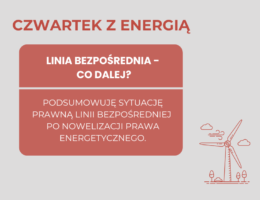Last September, a comprehensive amendment to the Energy Law came into effect, and one of its elements was the long-awaited reform of direct line regulation. The issue was widely reported, with both generators and electricity consumers hoping for a new opening to diversify supply on favorable terms. Unfortunately, the practical side of the new direct line regulations turned out to be less friendly than expected.
1. Direct line still unprofitable
The main incentive for the use of a direct line was to reduce the cost of acquiring electricity, directly from the source, bypassing the power grid and the associated distribution costs. Although in fact the costs do not occur with the use of a direct line, the legislator decided to introduce two fees – the so-called solidarity fee and to cover the costs of maintaining quality standards, which certain entities using energy transmitted by direct line are to pay to the relevant distribution system operator. The amount of the fees was not described quite clearly, as the provisions of Article 7aa (4) of the Energy Law do not provide detailed guidelines. Only Article 46(7) of the Energy Law and the Decree of the Minister of Climate and Environment on the Method of Forming and Calculating Tariffs and the Method of Settlements in Electricity Trading provide detailed information on how to calculate both fees. However, these depend on factors and costs specific to the distribution system operator, so a potential direct line investor has no practical tools to accurately determine the amount of future fees.
A case in which solidarity and quality standard maintenance charges will not occur is a situation in which a direct line connects an unbundled generation unit to an unbundled customer, i.e. one that is not connected to the power grid. Taking into account the practical aspects of such a solution, the actual implementation of this scenario – at least in the near term – can be considered unrealistic, since the entire electricity demand of such a customer would have to come from the direct line and possibly other sources. As a result, the most financially advantageous use of a direct line is significantly limited by technical aspects.
2. Practical application of the regulations – the distinction between direct line and other solutions
The definition of direct line does not answer all the questions that arise when planning investments in generation sources. The most questionable is the distinction between a direct line and an interconnection within the internal network of a grid-connected customer. As the example of the only direct line registered so far shows, the entirety of the generating and receiving facilities may be located on the same plot of land, and the length of the line itself may be symbolic (a few tens of meters). Consequently, it is difficult to indicate a clear criterion for what type of connection between a generating unit and a customer will constitute a direct line, and what no longer.
There are more doubts if we consider that the criterion for assessing the existence of technical and economic conditions for the issuance of connection conditions for a given installation, which lies within the competence of the relevant electricity system operator. This means that not only is it possible to have different interpretations of very similar cases, but also to conduct quasi interpretations of the regulations as to the legal nature of a direct line by power system operators. As a result, it may turn out that a similar-looking connection between a generating facility and an electricity consumer will be classified differently.
Another issue is whether a connection between a generating unit and a customer’s internal installation running through third-party parcels will always be a direct line. On the one hand, practical considerations support that such a connection should be considered a direct line. On the other hand, however, if we are talking about running a connection, for example, under a public road, when the entity that is the generator and the customer simultaneously holds legal title to the parcels of land lying opposite each other, it is not easy, in my opinion, to unequivocally recognize that we will be talking about a direct line. Evidently, the statutory criteria lack guidance on how to qualify such situations.
It remains to be hoped that the legislator will revise the provisions of the Energy Law and open the way to a wider use of direct line.



